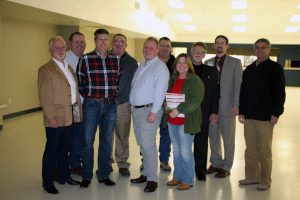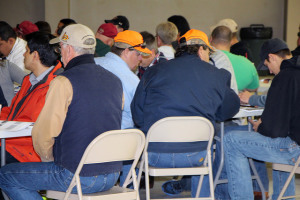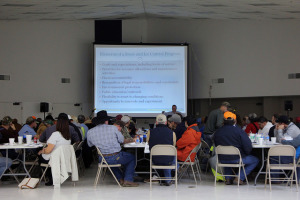KTEN.com – No One Gets You Closer
December 9 started off looking like winter when Cleveland County Road Crew members gathered at the District Barn. Fog was thick with a hazy overcast and the chill of winter was flirting with a sharp sting to the face. Myself along with 5 crew members braved the morning fog and headed to Ada for the Snow & Ice Maintenance Workshop. The Chickasaw Nation sponsored the LTAP (Local Technical Assistance Program, OSU School of Engineering) workshop. Matheu Carter, P.E. taught the workshop. Matheu is a Municipal Engineering Circuit Rider and part of the Delaware T2/LTAP Center.
The Winter Maintenance Program was present in 6 modules that covered; planning, pre-season preparation, operations in season, post storm maintenance and reporting and post season activities. The primary references were AASHTO Guide for Snow and Ice Control, APWA, the Salt Institute, Iowa Department of Transportation and NCHRP. The main objectives of the workshop focused on safety, performance and expectations to the public, cost effectiveness and the mobility and connectivity of your area of responsibility.
Winter Road Maintenance by the Numbers
- 116,000 people in America are injured each year
- 1,300 people are killed each year on snowy, slushy or icy roads
- Snowstorms cost states over 700 million per day in both direct and indirect costs when roads are impassable
- Sensible and affective use of salt can reduce highway crashes 80% and injuries 85%
Snow and Ice Removal Preparedness
In the heat of the summer is the time we start thinking about snow and ice removal on our county roads. Repairing, and prepping the equipment in the warm summer and fall months insure the readiness of the first snow event. Also, in the months before old man winter hits is the time to create a plan of action. This plan is defining the level of service that is expected by the citizens. However, the expectations have to have balance with the snow event, safety of the road crews and the effectiveness of the applications.
Four years ago the counties and municipalities that make of the Central Oklahoma Governments (ACOG) met over several months to create snow routes and responsibilities for snow and ice road maintenance. The plan was to have consistency of mobility between municipalities and the states transportation department. ACOG also sponsored a public relation campaign to the public. Communicating the 1st priority snow routes, the safety to stay off the roads until the storm passes and levels of service that the municipalities, counties and ODOT will perform in either snow or ice events. Here is the current Snow Route Map for the OCARTS area – 2014-2015_RegionalSnowRoutes .
The workshop covered training and safety for the road crews and for the public.
- Proper driving speeds for sand/salt spreaders
- Proper driving speeds for snow plows, graders and loaders
- Proper blade set up for graders and snow plows for effectiveness and road maintenance
- Use of sand versus salt or use of both.
Sand versus Salt when to use salt
Sand is used for abrasion and traction. Salt is used to breakdown ice but this creates wet surfaces that can also be just as slick. The combination of Sand and Salt does not always work in all weather conditions. Salt is most affective when the pavement temperature is above 28 degrees.
How Salt Works on Roads
Salt lowers water’s freezing point, the temperature at which it changes from a liquid to a solid and vice versa.
Melting water already frozen is called deicing. Preventing water from freezing in the first place is called anti-icing. Both methods give tires more traction with the pavement, keeping roads open and safe while protecting lives and commerce.
Any substance that dissolves in water lowers its freezing point, but each substance will have varying outcomes. For example, sugar can lower water’s freezing temperature, but salt’s lower molecular weight makes it six times more effective.
How quickly salt melts frozen water is dependent upon a number of variables, including temperature, time, and the rate of application. Fortunately, it is usually not necessary to melt all the snow and ice on a road. Merely destroying or preventing the bond between pavement and frozen water is a more efficient, economical and environmentally sensitive approach. (www.safewinterroads.org)
This is a list of common road treatment materials
- Salt (sodium chloride)
- Calcium Chloride
- Magnesium Chloride
- Potassium Chloride
- Brines (by-product of gas production)
- Potassium Acetate
- Calcium Magnesium Acetate
- Urea
- Abrasives (sand, screenings)
The standard amount of salt use per 2 lane mile road is 500lbs per storm event. Cleveland County District 1 is responsible for 51 miles of snow routes and an additional 50 miles of secondary roads in District 1. We plan for 6 snow and/or ice events per winter season. We budget for 200 tons of rock salt at a cost of $96 per ton or a total of $19,200 and several hundred tons of sand and screening to mix with the salt.
So as winter approaches in a few days, start planning your snow and ice events. When a snow event is fore casted, plan your travels, get your chores and errands done before the event happens and stay off the road or stay away from the road crews so they can get their job done and make the roads safe and passable.

County Commissioners, Chickasaw Nation Transportation Department, Oklahoma Department of Transportation and LTAP employees


